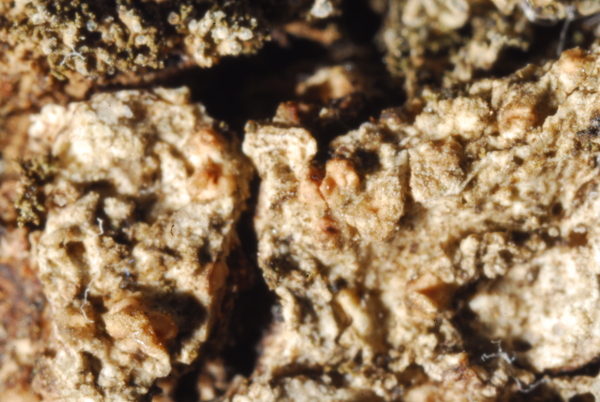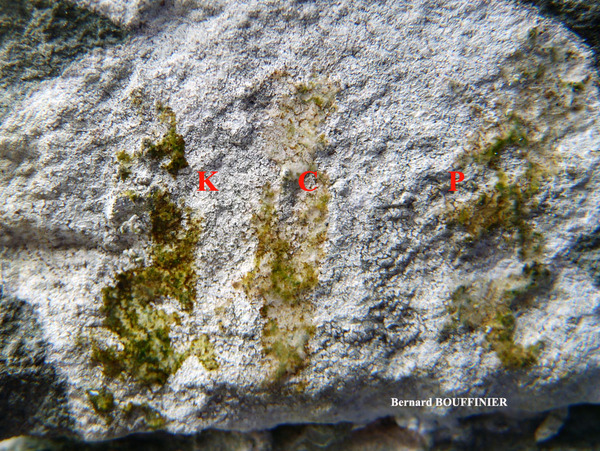Gyalecta nidarosiensis (Kindt) Baloch & Lücking
in Baloch & al., Lichenologist, 45: 724, 2013. Basionym: Microglaena nidarosiensis Kindt - Kgl. norske vidensk. Selsk. Skr.: 4, 1884.
Synonyms: Belonia caudata (Vězda & Vivant) P.M. Jørg. & Vězda; Belonia nidarosiensis (Kindt) P.M. Jørg. & Vězda; Clathroporina calcarea Walt. Watson; Clathroporina caudata Vězda & Vivant; Clathroporinopsis nidarosiensis (Kindt.) P.F. Cannon
Distribution: S - Cal (Puntillo 1996).
Description: Thallus crustose, thinly episubstratic, pale pink-orange, turning white in the herbarium, ecorticate, completely dissolved into an uneven, granular-powdery, continuous or irregularly cracked crust, without a distinct prothallus, often forming large patches. Ascocarps usually rare, pale pink to ochraceous, immersed in globose, 0.25-0.4 mm wide thalline warts, at first perithecioid and opening through a small, depressed pore, later sometimes with a slightly expanded, pale brown disc, and a thick, raised proper margin. Proper exciple 30-55 µm wide laterally, broadening in upper part, of more or less rectangular cells; hymenium colourless, the hymenial gel hemiamyloid, I+ blue-green rapidly turning reddish brown; paraphyses loose, simple, slender and flexuose, 1-1.4 µm thick, the apical cells not swollen; hypothecium colourless. Asci (4-)6-8-spored, narrowly cylindrical, very thin-walled, without apical thickening or apparatus. Ascospores at first (7-)12-15(-19)-transversally septate, soon becoming muriform, hyaline, elongate with attenuated ends, (36-)40-65(-82) x (8-)10-12(-14) µm, sometimes clearly constricted at the middle septum when young. Photobiont trentepohlioid. Spot tests: thallus K-, C-, KC-, P-, UV-. Chemistry: without lichen substances.Note: hitherto known only from the Austrian and French Alps, and from Calabria, where it was found on Quercus in a very humid site; it usually occurs on shaded surfaces of calcareous rocks in very humid situations, often in association with Lepraria-species. It is included in the Italian red list of epiphytic lichens as “Critically Endangered” (Nascimbene & al. 2013c).
Growth form: Crustose
Substrata: bark and rocks
Photobiont: Trentepohlia
Reproductive strategy: mainly sexual
Most common in areas with a humid-warm climate (e.g. most of Tyrrenian Italy)
Commonnes-rarity: (info)
Alpine belt: absent
Subalpine belt: absent
Oromediterranean belt: absent
Montane belt: extremely rare
Submediterranean belt: absent
Padanian area: absent
Humid submediterranean belt: extremely rare
Humid mediterranean belt: absent
Dry mediterranean belt: absent
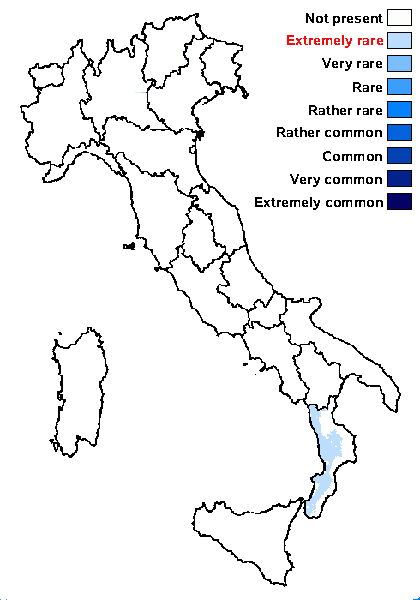
Predictive model
Herbarium samples
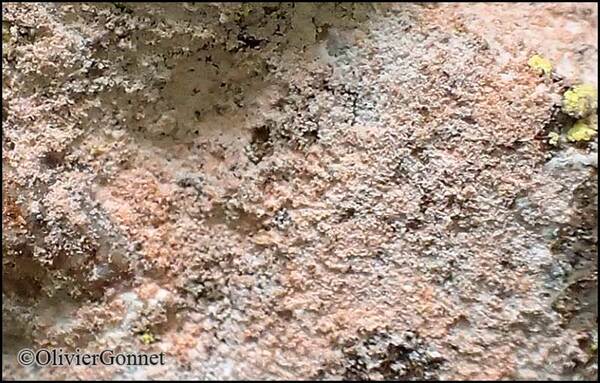
Courtesy Danièle et Olivier Gonnet - Source: https://www.afl-lichenologie.fr/Photos_AFL/Photos_AFL_G/Gyalecta_nidarosiensis.htm
France, session AFL 2015 - La Chapelle Auzac - Blagour - Lot
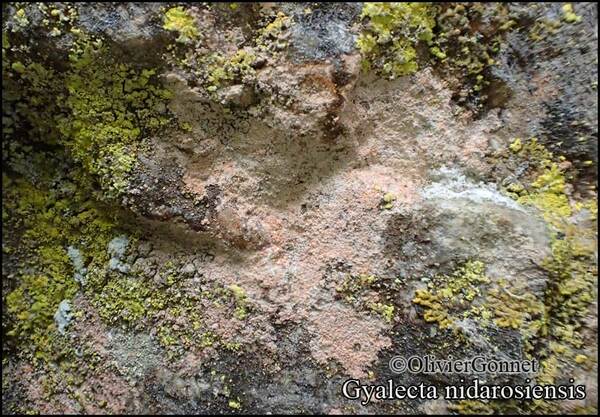
Courtesy Danièle et Olivier Gonnet - Source: https://www.afl-lichenologie.fr/Photos_AFL/Photos_AFL_G/Gyalecta_nidarosiensis.htm
France, session AFL 2015 - La Chapelle Auzac - Blagour - Lot
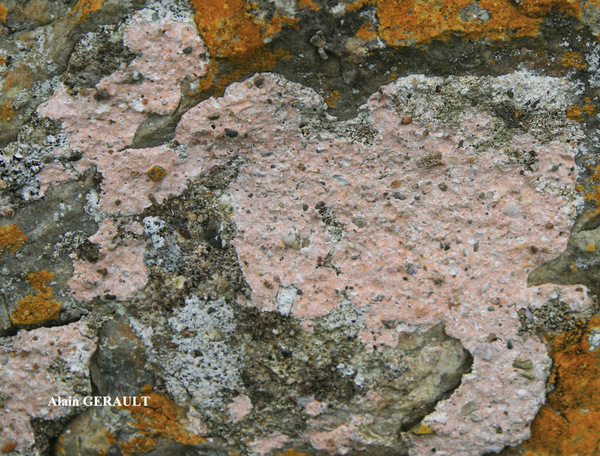
Alain Gerault - Source: http://www.lichensmaritimes.org/index.php?task=fiche&lichen=319&lang=en
France, Sur mur, Camaret
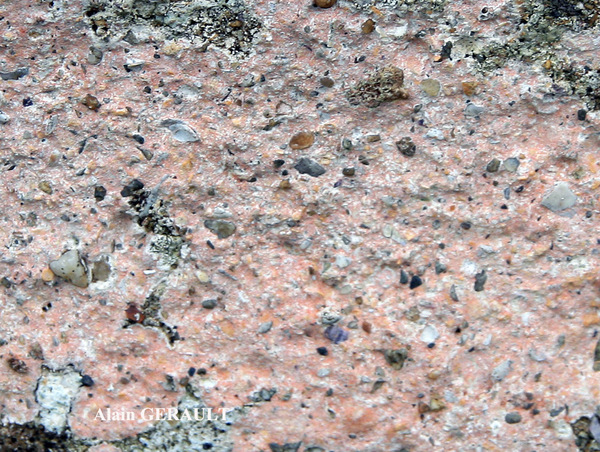
Alain Gerault - Source: http://www.lichensmaritimes.org/index.php?task=fiche&lichen=319&lang=en
France, Sur mur, Camaret

Bernard Bouffinier - Source: http://www.lichensmaritimes.org/index.php?task=fiche&lichen=319&lang=en
France, Crozon
Growth form: Crustose
Substrata: bark and rocks
Photobiont: Trentepohlia
Reproductive strategy: mainly sexual
Most common in areas with a humid-warm climate (e.g. most of Tyrrenian Italy)
Commonnes-rarity: (info)
Alpine belt: absent
Subalpine belt: absent
Oromediterranean belt: absent
Montane belt: extremely rare
Submediterranean belt: absent
Padanian area: absent
Humid submediterranean belt: extremely rare
Humid mediterranean belt: absent
Dry mediterranean belt: absent

Predictive model
| Herbarium samples |

Courtesy Danièle et Olivier Gonnet - Source: https://www.afl-lichenologie.fr/Photos_AFL/Photos_AFL_G/Gyalecta_nidarosiensis.htm
France, session AFL 2015 - La Chapelle Auzac - Blagour - Lot

Courtesy Danièle et Olivier Gonnet - Source: https://www.afl-lichenologie.fr/Photos_AFL/Photos_AFL_G/Gyalecta_nidarosiensis.htm
France, session AFL 2015 - La Chapelle Auzac - Blagour - Lot

Alain Gerault - Source: http://www.lichensmaritimes.org/index.php?task=fiche&lichen=319&lang=en
France, Sur mur, Camaret

Alain Gerault - Source: http://www.lichensmaritimes.org/index.php?task=fiche&lichen=319&lang=en
France, Sur mur, Camaret

 INDEX FUNGORUM
INDEX FUNGORUM
 GBIF
GBIF
